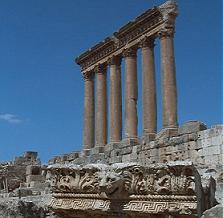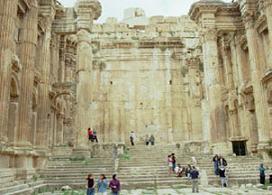Baalbeck Profile Altitude:
1050 m
Distance from Beirut: 85km
Getting
there
Take the main international Damascus Highway winding up Lebanon's mountains,
pass villages like Aley, Bhamdoun, Sofar, Dahr el-Baidar, Chtaura, Zahle, Riyak
and then to Baalbeck. |
 |
Baalbeck’s Lebanon temples were built around the first millennium B.C. The enclosed
court was built on the ancient tell. The more accurate history of Baalbeck
first begins during the Hellenistic period (333-64 B.C.). The Greeks
identified the god of Baalbeck with the sun god and enlarged the court. The
temple was begun in the last quarter of the first century B.C., and was
nearing completion in the last years of Nero’s reign. The Great Court Complex
of the Temple of Jupiter was built in the second century A.D. The other
addendum courts to the Jupiter Temple were added in the third century.
The
Baalbeck temples were officially closed in 313 A.D., when Byzantine Emperor
Constantine officially closed them. Since then these monuments have gone through
many transformations, falling under Arab domination, and the Omayyad, Abbasid,
Toulounid, Fatimid and Ayyoubid dynasties. It was sacked by the Mongols in 1260,
but later has enjoyed a period of calm and prosperity.
Overview
Baalbeck,
Lebanon's greatest Roman treasure, can be counted among the wonders of the
ancient world. The largest and most noble Roman temples ever built, they are
also among the best preserved.
Towering high above the Beqaa plain, their monumental proportions
proclaimed the power and wealth of Imperial Rome. The gods worshipped here,
the Triad of Jupiter, Venus and Mercury, were grafted onto the indigenous
deities of Hadad, Atargatis and a young male god of fertility. Local
influences are also seen in the planning and layout of the temples, which vary
from the classic Roman design.
Over the centuries Baalbeck's
monuments suffered from theft, war and earthquakes, as well as from numerous
medieval additions.
Fortunately, the modern visitor can see the site in something close to its
original form thanks to work in the past hundred years by German, French and
Lebanese archaeologists.
The Temples In History
For centuries the temples of
Baalbeck lay under meters of rubble, obscured by medieval fortifications. But
even in ruin the site attracted the admiration of visitors and its historical
importance was recognized.
The first survey and restoration work at Baalbeck was begun by the German
Archaeological Mission in 1898. In 1922 French scholars undertook extensive
research and restoration of the temples, work which was continued by the
Lebanese Directorate General of Antiquities.
Baalbeck's temples were built on an ancient tell that goes back at least
to the end of the third millennium B.C. Little is known about the site during
this period, but there is evidence that in the course of the 1rst millennium
B.C. an enclosed court was built on the ancient tell. An altar was set in the
center of this court in the tradition of the biblical Semitic high places.
During the Hellenistic period (333-64 B.C.) the Greeks identified the god
of Baalbeck with the sun god and the city was called Heliopolis or City of the
Sun. At this time the ancient enclosed court was enlarged and a podium was
erected on its western side to support a temple of classical form. Although
the temple was never built, some huge construction from the Hellenistic
project can still be seen. And it was over the ancient court that the Romans
placed the present Great Court of the Temple of Jupiter.
The temple was begun in the last
quarter of the 1rst century B.C., and was nearing completion in the final
years of Nero's reign (37-68 A.D.). the Great Court Complex of the temple of
Jupiter, with its porticoes, exedrae, altars and basins, was built in
the 2nd century A.D. Construction of the so-called temple of Baalbeck Bacchus was also
started about this time.
The Propylaea and the Hexagonal Court of the Jupiter temple
were added in the 3rd century under the Severan Dynasty (193-235 A.D.) and
work was presumably completed in the mid-3rd century. The small circular
structure known as the Temple of Venus, was probably finished at this time as
well.
 |
. |
When Christianity was declared an official religion of the Roman Empire in 313
A.D., Byzantine Emperor Constantine officially closed the Baalbeck temples. At
the end of the 4th century, the Emperor Theodosius tore down the altars of
Jupiter's Great Court and built a basilica using the temple's stones and
architectural elements. The remnants of the three apses of this basilica,
originally oriented to the west, can still be seen in the upper part of the
stairway of the Temple of Jupiter. |
After the Arab conquest in 636 the temples were transformed into a fortress,
or qal'a, a term still applied to the Acropolis today.
During the next centuries Baalbeck fell successively to the Omayyad, Abbasid,
Toulounid, Fatimid and Ayyoubid dynasties. Sacked by the Mongols about 1260,
Baalbeck later enjoyed a period of calm and prosperity under Mamluke rule.
The Great Temple or "Jupiter Temple"
The first view the visitor has of Baalbeck is the six
Corinthian columns of the Great Temple thrusting 22 meters into the skyline.
Built on a podium seven meters above the Court, these six columns and the
entablature on top give an idea of the vast scale of the original structure.
The complex of the Great Temple has four sections: the monumental entrance or
Propylaea, the Hexagonal Court, the Great Court and finally the Temple itself,
where the six famous columns stand.
The Great Court
Built in the 2nd century A.D., covered an area 134x112 meters
and contained the main installation of the cult. Structurally, the court is a
platform built on the leveled-off top of the ancient artificial tell. The tell
was consolidated on the eastern, northern and southern sides by vaulted
substructures, and on the western side by the temple's podium. These
substructures supported the porticos and exedrae around the Court and were
used for stables and storage.
Two huge structures stand in the center of the Great Court: a restored
sacrificial altar and a tower with only the lower courses remaining. The
tower, dating from the beginning of the 1st century A.D., was probably built
to allow the worshipers to view the proceedings from the top. It was flanked
by two solitary columns of gray and red granite. two pools for ritual washing,
decorated with relief carvings, were placed north and south of both altar and
tower. these structures were destroyed when a Christian basilica was built on
the site at the end of the 4th century.
 |
|
The entire Court was enclosed by a succession of rectangular and semi-circular
exedrae or recesses decorated by niches which contained statues. Surrounding
the Court, in front of the exedrae, was an 84-column Corinthian colonnade of
Egyptian granite. on the exterior walls of the Court the remains of medieval
battlements
can still be seen. |
The Propylaea
The Propylaea completed in the mid-3rd century A.D., is approached by a large
semicircle of stone benches and a partially restored stairway. The entrance
structure has towers at either end and is fronted by 12 granite columns. An
interior stairway goes to the top of the Propylaea where there is an excellent
view of the area.
The Hexagonal Forecourt
Three doors lead to the Hexagonal Forecourt where 30 granite columns
originally supported the entablature. This six-sided form was built between
the Propylaea and the Great Court in the first half of the 3rd century A.D. At
the end of the 4rth century or the early 5th century, it was covered with a
dome and transformed into a church.
Temple of Jupiter
After passing through the Propylaea, the Hexagonal Forecourt and Great Court,
the worshiper at last arrived at the Temple of Jupiter. This approach to the
sanctuary through a series of defined spaces was an apparent oriental
adaptation.
The Temple measures 88x48 meters and stands on a podium 13 meters above the
surrounding terrain and 7 meters above the courtyard. It is reached by a
monumental stairway. Originally surrounded by 54 external columns, most of
these now lie in fragments on the ground. The six standing columns are joined
by an entablature decorated with a frieze of bulls and lions' heads connected
by garlands. The Podium is built with some of the largest stone blocks ever
hewn. On the west side of the podium is the "Trilithon", a celebrated group of
three enormous stones weighing about 800 tons each.
Information From the Ministry of
Tourism

|